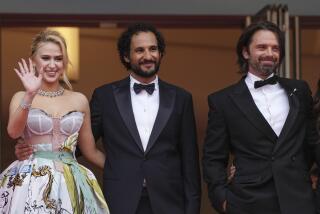A master at being himself
Spalding Gray, the New York-based monologuist whose January disappearance was confirmed Monday as a suicide, left his mark on a wide range of performers, many of whom cite him as a stimulus to their own solo work.
In interviews this week, these actors pointed to the simplicity of Gray’s staging, his matter-of-fact delivery and his acute sense of self.
“He’s like the guy who taught everybody how to do it,” said Julia Sweeney, a Los Angeles-based solo performer and former “Saturday Night Live” cast member. “ ‘Swimming to Cambodia’ was a huge, huge, huge inspiration to me.”
Gray, 62, was perhaps best known for the 1987 Jonathan Demme film of that monologue. He began doing autobiographical stage work in ensemble pieces with New York’s Performance Group and the Wooster Group (which he co-founded in 1977) but then embarked on a series of solo works.
With his mix of despair, humor, preppy shirts and New England dryness, he was sometimes called “the WASP Woody Allen.” But many of those inspired by his techniques went in very different directions. Some created aural collages; some explored their ethnicity; others became ranters. John Leguizamo, Danny Hoch and Eric Bogosian, at various times, did all three.
Anna Deavere Smith, whose “Twilight: Los Angeles, 1992” featured her doing a colloquy of voices from the L.A. riots, took insights learned from Gray to make her multivoiced documentaries. She remembers a workshop Gray led in Pittsburgh in the 1970s. “He introduced me to the idea that normal human behavior is performative,” she said from New York. “He was very self-conscious of the movements he made, like the lifting of an eyebrow, the movement of a hand. This was the first time I thought of a person performing himself -- and not just as a monologuist.” That lesson, Smith said, fed into the way she listened to and watched the people whose words and gestures she later re-created in her shows.
“In a way he was the uber straight guy,” said L.A.-based gay performance artist Tim Miller. “But what it encouraged in me was the radical queer performer. It was the power of telling the story. The grace and depth of feeling Spalding brought to his work created many new avenues that others could pursue.”
Miller met Gray while a teenage “little punk from L.A.,” just beginning his work in solo performance, and found him very supportive and encouraging, then and throughout his career.
In 2002, UCLA Live held a Solo Festival, much of it involving artists inspired by Gray. “Spalding, more than anyone else, made the monologue an accepted theatrical form,” said David Sefton, who created the festival and remounted “Swimming to Cambodia” with Gray.
Sefton said he discussed Gray’s work with a number of artists, including European monologuists and the musician Laurie Anderson, who, he says, was fascinated with Gray. “He gave respect to the monologue, and showed that you could do that, just sitting there with a glass of water,” Sefton said.
Bogosian, who saw Gray’s first monologue in New York in 1979, also went backstage to meet Gray after a performance by the older actor in a Sam Shepard play.
“I was just a kid. I’d just moved to New York. He took me out for a drink,” Bogosian said.
But despite what he described as a reputation as a “punky kid brother” to Gray -- the two were once portrayed in a “Saturday Night Live” skit as opponents in a performance-artist boxing match -- Bogosian said Gray’s influence on him was indirect. “He was influential on me by making me ask, ‘What is theater, and what are you doing when you step out on a stage?’ But he was very hard to imitate.”
Bogosian also said many of Gray’s followers misunderstand his work. “On the surface, it might seem confessional or autobiographical, but he was finding the theatricality of everyday life. It was very subtle what he was doing.”
Gray’s other performance pieces included “Monster in a Box” (which became a 1992 film), “Gray’s Anatomy,” “It’s a Slippery Slope” and his first formal monologue, “Sex and Death to the Age 14.” His early ensemble work with the Wooster Group was visually elaborate. But the minimalist aesthetic of his later monologues -- he became famous for performing with only a glass of water on a desk, sometimes with notes on sheets of paper -- also left their stamp.
Miller pointed out that while this plain style had its roots in traditional American storytelling, Gray gave it a new currency: His pieces, Miller said, were stripped down “to just the performance, the artist, the story -- which is the way I perform now.”
“The extremely personal tone and monkish simplicity laid out the self in a very vulnerable way,” said Michael Peterson, author of “Straight White Male: Performance Art Monologues” and a University of Wisconsin theater professor. “It’s what a lot of other solo performers have taken in a very personal direction -- the sense of personal risk and sacrifice. People sometimes missed the performance art quality of him. Sitting there with a notebook allowed him to stage a self-conscious and reflective encounter with himself, and other solo performers picked up on this, this self-interrogation.”
Writer and performer Sandra Tsing Loh, known for her radio commentaries, said “Swimming to Cambodia” and Gray’s other “free-ranging and prose-like and lyrical” monologues had a strong effect on her. “It was so astonishing that that could be theater in itself,” she said. “He wasn’t the first great monologuist, but he was the king.”
In what she called “the early days of multicultural performance,” around 1990, “we were all doing it Spalding Gray style: ‘Here’s my stool, my glass of water.’ Also, the layers of neuroses.”
In addition to its aesthetic effect, Gray’s visibility built demand from audiences and performance spaces. “If people said, ‘What is a monologue?’ you could say, ‘It’s like Spalding Gray, but I stand up,’ ” Loh said.
Sweeney, who took the monologue in a tragicomic direction with the performance and film “God Said, ‘Ha!’ ” -- about her brother’s battle with cancer -- recalled being floored when she saw the film of “Swimming to Cambodia” as a young actress. “The whole idea that one person could walk in and just talk -- I had never seen anything like that before. I tried to have his relaxed style. He was like, ‘We’re at a dinner party, and now it’s my time to talk for as long as I want.’ That’s the style I wanted.”
Years later, she watched the movie over and over again to prepare for filming her own play.
“People are reacting as if they knew him,” scholar Peterson said of the responses to Gray’s death. “I think it was the confessional mode of his work. At the countercultural and bohemian level, people are mourning him all over the country.”
Sandra Bernhard, whose shows at times resemble a manic version of Gray’s, referred to his disappearance during a performance last month at UCLA. “It’s that bipolar thing that everybody’s getting away with these days,” she said then. “I can think of so many other performers that I wish had done it.”
More to Read
The biggest entertainment stories
Get our big stories about Hollywood, film, television, music, arts, culture and more right in your inbox as soon as they publish.
You may occasionally receive promotional content from the Los Angeles Times.






